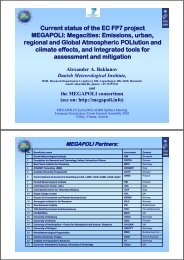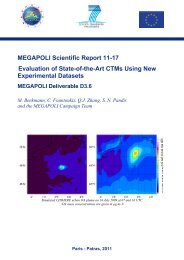D E S C R I P T I O N O F W O R K - MEGAPOLI - Dmi
D E S C R I P T I O N O F W O R K - MEGAPOLI - Dmi
D E S C R I P T I O N O F W O R K - MEGAPOLI - Dmi
Create successful ePaper yourself
Turn your PDF publications into a flip-book with our unique Google optimized e-Paper software.
<strong>MEGAPOLI</strong> 212520<br />
authored ~ 30 peer-reviewed articles on mechanisms, emission and mitigation of non-CO2 greenhouse gases,<br />
particulate matter, heavy metals and POP and participated in 3 EU projects. (FP-5, FP-6). He is a reviewer<br />
for the IPCC guidelines (2006) and contributor to IPCC Good Practice Guidance and Uncertainty<br />
Management in National Greenhouse Gas Inventories (2000)<br />
Dick van den Hout is a senior scientist at TNO and has been responsible for improving the user orientation<br />
of research in several FP research projects and networks, e.g. the Integaire network on urban air pollution<br />
mitigation. Since 1993 he has been the Commission’s primary consultant on the development and<br />
implementation of air pollution policies and legislation. He has participated in many international working<br />
groups, of which several dealt with abatement strategies. He has been the head of the European Topic Centre<br />
on Air Quality and is a visiting Prof. at the University of Hertfordshire, UK.<br />
Recent and relevant publications<br />
Schaap M., H.A..C. Denier van der Gon, (2007): On the variability of Black Smoke and carbonaceous aerosols in the<br />
Netherlands, Atmospheric Environment, In Press.<br />
Schaap, M.; Denier Van Der Gon, H. A. C; Dentener, F. J.; Visschedijk, A. J. H.; Van Loon, M.; ten Brink, H. M.;<br />
Putaud, J.-P.; Guillaume, B.; Liousse, C.; Builtjes, P. J. H. (2004): Anthropogenic black carbon and fine aerosol<br />
distribution over Europe, J. Geophys. Res., 109 (D18), D18207,10.1029/2003JD004330.<br />
Denier van der Gon H.A.C., A. Bleeker, (2005): Indirect N2O emission due to atmospheric N deposition for the<br />
Netherlands, Atmospheric Environment, 39, 5827–5838.<br />
Denier van der Gon, H.A.C., M.J. Kropff N. van Breemen, R. Wassmann, R.S. Lantin, E. Aduna, T. M. Corton , H.H.<br />
van Laar, (2002): Optimizing grain yields reduces CH4 emissions from rice paddy fields, Proceedings National<br />
Academy of Sciences (PNAS) USA, 99 (19), 12021-12024.<br />
Schaap M., F. Sauter, R.M.A. Timmermans, M. Roemer, G. Velders, J. Beck, P.J.H. Builtjes (2007): The LOTOS-<br />
EUROS model: description, validation and latest developments, Int. J. of Environmental Pollution, In Press.<br />
Partner 15: UK MetOffice (MetO)<br />
Expertise and experience of the organization<br />
The Met Office has well over 20 years of world-leading expertise in climate modelling. Currently 150<br />
scientists research climate science in the Met Office’s Hadley Centre for Climate Change. The fields<br />
represented include climate monitoring, climate modelling, climate variability, quantifying uncertainty,<br />
understanding climate change, and climate-chemistry-ecosystem feedbacks. Research on atmospheric<br />
composition and climate includes global modelling of aerosol and gas-phase reactive chemical constituents.<br />
The focus here is on the direct and indirect radiative and climate impacts of these constituents through their<br />
interactions with clouds, terrestrial and ocean ecosystems and the land surface. The atmospheric composition<br />
team are currently participating in the EU projects EUCAARI, ACCENT and GEMS.<br />
Role and contribution<br />
The Met Office will co-lead WP6 and will contribute significantly to WP5. In WP6 the Met Office will lead<br />
the work on global climate effects of megacities and will contribute with its HadGEM2 climate model which<br />
includes the UKCA package of interactive aerosols and reactive gases. In WP5 the Met Office will<br />
contribute to tasks 5.5 and 5.6.<br />
Principal personnel involved<br />
Dr. William Collins<br />
Graduated from the University of Cambridge with a degree in Natural Sciences and a PhD in Particle<br />
Physics. He holds an MSc in Weather and Climate from the University of Reading. He has worked in the<br />
Met Office for since 1993 and with others built the Met Office tropospheric chemistry transport model. He is<br />
involved in the EU EUCAARI project and has previously been involved in STACCATO. He has contributed<br />
as a co-author to the IPCC third assessment report, and as an expert reviewer to the IPCC forth assessment<br />
report. He has authored, or co-authored over 40 peer-reviewed papers.<br />
Dr. Olivier Boucher<br />
Olivier Boucher gained a PhD in Physics in 1995 and an Habilitation in Physics in 2003. He was a junior<br />
scientist at the Centre National de la Recherche Scientifique (CNRS) from 1996 to 2005. He is now a senior<br />
scientist at the CNRS on secondment to the Met Office which he joined in 2005 as Head of the “Climate,<br />
Chemistry, Ecosystems” team. His main speciality is the study of the climatic effects of aerosols in relation<br />
to radiation and clouds. Olivier has been a lead author in the IPCC Special Report on Aviation and the<br />
Global Atmosphere and the IPCC Working Group I Third Assessment Report.<br />
Dr. Michael Sanderson,<br />
D.Phil in Atmospheric Chemistry (1994) has published over 20 articles in peer-reviewed literature in the<br />
field of atmospheric chemistry. Research work has included, modelling of global trace gas concentrations,<br />
84




